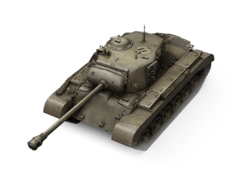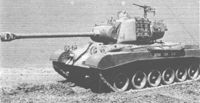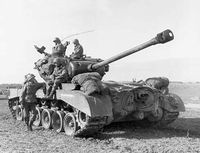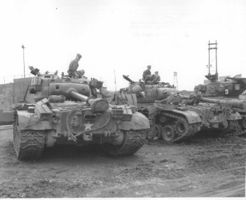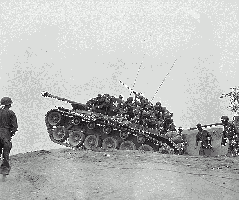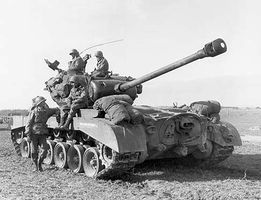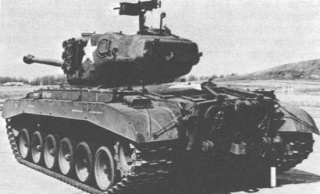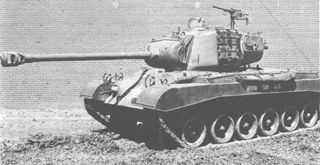M26 Pershing
- For the premium vehicle, see T26E4 Super Pershing.
Pershing (Stock)
| 2403000 Cost |
| 1350 HPDurability |
| 40.56 / 45.05 Weight |
- Commander
- Gunner
- Driver
- Radio Operator
- Loader
| 101.6/76.2/50.8Hull Armor(front/sides/rear, mm) |
| 101.6/76.2/76.2Turret Armor(front/sides/rear, mm) |
| 560 h.p.Engine Power |
| 48 km/hTop Speed / Reverse Speed |
| 38 deg/sTraverse Speed |
| 160 damage |
| 128 mmAverage Penetration |
| 6.0080464908 Time for Complete Loading |
| 36 deg/sGun Traverse Speed |
| 260 mView Range |
| 500 mSignal Range |
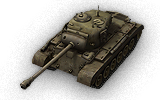
Compared to other tier 8 medium tanks, Pershing armor is excellent and capable of bouncing low-tier guns. However, like all other medium tanks, it does not fare well on its own and will easily get destroyed if caught in the open by tank destroyers or heavy tanks. Therefore, it acts better as a mobile mid-range sniper or as support for heavier tanks. After you get the upgraded engine, the Pershing becomes much faster and can plug holes in whichever areas are needed. Its top gun is effective in the supporting role, but will find itself outclassed when fighting most heavies from the front.


Turret
| Level | Turret | Turret Armor (front/sides/rear, mm) | Gun Traverse Speed (deg/s) | View Range (m) | Experience | Weight (t) |
|---|---|---|---|---|---|---|
| VII | M26M67 | 101.6/76.2/76.2 | 36 | 260 | 0 | 8000 |
| Level | Gun | Average Penetration (mm) | Rate of Fire | Dispersion at 100 m | Aiming Time | Experience | Weight (t) | |
|---|---|---|---|---|---|---|---|---|
| VI | 76 mm Gun M1A1 | 128/177/20 | 160/160/200 | 9.99 | 0.43 | 2.3 | 0 | 1567 |
| VI | 76 mm Gun M1A2 | 128/177/20 | 160/160/200 | 12.79 | 0.4 | 2.3 | 6840 | 1590 |
| VII | 90 mm Gun M3 | 160/243/45 | 225/225/270 | 7.87 | 0.38 | 2.3 | 16520 | 2050 |
| VIII | 90 mm Gun T15E2M2 | 180/268/45 | 225/225/270 | 7.87 | 0.37 | 2.3 | 23630 | 2250 |
| Level | Turret | Turret Armor (front/sides/rear, mm) | Gun Traverse Speed (deg/s) | View Range (m) | Experience | Weight (t) |
|---|---|---|---|---|---|---|
| VIII | M26M71 | 127/76.2/63.5 | 38 | 260 | 19500 | 9700 |
| Level | Gun | Average Penetration (mm) | Rate of Fire | Dispersion at 100 m | Aiming Time | Experience | Weight (t) | |
|---|---|---|---|---|---|---|---|---|
| V | 105 mm M4 | 30/101.6/20 | 400/250/200 | 8.02 | 0.55 | 2.5 | 1880 | 2600 |
| VI | 76 mm Gun M1A1 | 128/177/20 | 160/160/200 | 9.99 | 0.43 | 2.3 | 0 | 1567 |
| VI | 76 mm Gun M1A2 | 128/177/20 | 160/160/200 | 12.79 | 0.4 | 2.3 | 6840 | 1590 |
| VII | 90 mm Gun M3 | 160/243/45 | 225/225/270 | 7.87 | 0.38 | 2.3 | 16520 | 2050 |
| VIII | 90 mm Gun T15E2M2 | 180/268/45 | 225/225/270 | 7.87 | 0.37 | 2.3 | 23630 | 2250 |

Engine
| Level | Engine | Engine Power (h.p.) | Chance of Fire on Impact | Experience | Weight (t) |
|---|---|---|---|---|---|
| VII | Ford GAN | 560 | 20 | 0 | 569 |
| VIII | Continental AV-1790-1 | 704 | 20 | 13130 | 569 |

| Level | Suspension | Load Limit | Traverse Speed (deg/s) | Experience | Weight (t) |
|---|---|---|---|---|---|
| VII | M26T80E1 | 45.05 | 38 | 0 | 10000 |
| VIII | M26T81 | 45.05 | 41 | 13500 | 10000 |

Radio
| Level | Radio | Signal Range (m) | Experience | Weight (t) |
|---|---|---|---|---|
| VI | SCR_508_US | 500 | 0 | 100 |
Compatible Equipment
Compatible Consumables
Player Opinion
Pros and Cons
Pros:
- High view range
- Very good gun handling both on the move and while turning the turret
- Extremely high APCR penetration, proportionally, compared to gains most tanks see
- Thick mantlet
- Very good gun depression
Cons:
- Typically low AP pen of most older tier VIII mediums
- Somewhat large size leads to lower camouflage values than other mediums
- Relatively low firerate and DPM
Performance
A very solid tier 8 tank, the Pershing can excel as a support, flanker, sniper and is hard to dislodge in a hull down position. Just remember to use your brain when playing this tank - use superior mobility to outflank heavy tanks and TDs and superior terrain abuse to outplay your medium peers.
Another note is the Pershing's extremely durable gun mantlet. Using hull down against most enemies is extremely effective due to the great gun depression, said turret durability and front placement of the turret, which allows most or all of the hull to be hidden under terrain in most situations.
Just like the majority of American mediums, the M26 can passive scout quite well. With 400m of view range, this tank is very adept at the job, especially when compared to other tier 8s. Use this to gain sight lines on key areas of the map.
Early Research
- The 90mm M3 carries over from them T20
- The stock suspension can hold both the top engine and gun, so go for both
- Top engine is shared with T25 AT and T25/2.
- Get the suspension
- Get the turret
- Get the radio, which is also the top radio of the T29, Chaffee, and T21
Historical Info
The M-26 was developed near the end of World War II and named after World War One General John J Pershing of the American Expeditionary Force. The M26 Pershing had a slow and arduous beginning, when the need for a heavy tank was not in the priorities of the US Army. Instead, efforts were relegated to production of M3 Stuart Light Tanks and M4 Sherman Medium Tanks. It was not until the debut of the German Panther and Tiger series of tanks on the battlefields of Europe that the need for a heavily-armed, and armored, weapons system came to bear.
Considerable effort was then made to develop a gun system capable of competing with the German counterparts. The result was the M26 Pershing armed with a 90mm main gun (nearly on par with the German '88') and heavily armored overall. It was the closest weapon that the Allies would field that was akin to the German Panther, in terms of firepower and crew survivability. The M26 Pershing arrived too late to be of any effective use (overall) in the European Theater, but a few (roughly 200) saw service with the 3rd and 9th Armored Divisions. At least 100 were kept in reserve as well.
The mammoth M26 Pershings would be part of the armored column that would cross the Remagen Bridge over the Rhine River and into Germany with the 9th Armored. About 20 M26s were reported to have seen any action at all. Ten M26s were also shipped out to the Pacific Theater for action in Okinawa, though arriving too late to be of any effective tactical use.
This was not the end of the line for the M26, however, as a total of 309 M26 Pershings were rushed to Korea in 1950 to provide extra firepower to counter the T-34/85s. A 1954 survey concluded that there were in all 119 tank vs. tank actions involving U.S. Army and Marine units during the Korean War, with 97 T-34-85 tanks knocked out and another 18 probable. The M4A3E8 was involved in 50% of the tank actions, the M26 in 32%, and the M46 in 10%. The M26/M46 proved to be an overmatch for the T-34-85 as its 90 mm HVAP round could punch all the way through the T-34 from the front glacis armor to the back, whereas the T-34-85 had difficulty penetrating the armor of the M26/46. The M4A3E8, firing 76 mm HVAP rounds which were widely available during the Korean War (unlike World War II), was equal to the T-34-85 as both tanks could destroy each other at normal combat ranges.Although the M26 proved effective against the armour of the T-34/85s, the automotive deficiencies of the M26 in the mountainous Korean terrain became more of a liability, and so all M26s were withdrawn from Korea during 1951 and replaced with older up-gunned M4A3 Shermans and the newer M46 Pattons.
Post-war use saw a great number stationed throughout Europe with NATO through the Cold War, however, many were quickly replaced when the more reliable M46 Patton became available. Many alternative variants were devised, though some, like the self-propelled gun platform, not used by the US Army.
The M26 Pershing would later be reclassified as a Medium Tank and become the blueprint for tanks such as the M46, M47, M48 Patton, and M60 Main Battle Tanks. In 1948, the M26E2 version with a new more powerful and reliable engine and transmission became the M46 General Patton, which in turn was up-gunned and modified resulting in the M47 and eventually the M60 patton.
Historical Gallery
Sources and External Links
| Light Tanks | IT1 Cunningham • IIT1E6 • IIT2 Light Tank • IIT7 Combat Car • IIIM22 Locust |
| Medium Tanks | IIT2 Medium Tank • IIIM2 Medium Tank • IVM3 Lee • VM4A2E4 Sherman • VM4 Sherman • VRam II • VIM4A3E8 Fury • VIM4A3E8 Sherman • VIM4A3E2 Sherman Jumbo • VIIT20 • VIIIM26 Pershing • VIIIT26E4 SuperPershing • IXM46 Patton • XM48A1 Patton |
| Heavy Tanks | VT14 • VT1 Heavy Tank • VIM6 • VIIT29 • VIIIT32 • VIIIT34 • VIIIT34 Independence • IXM103 • XT110E5 |
| Tank Destroyers | IIT18 • IIIT82 • IVM8A1 • IVT40 • VM10 Wolverine • VT49 • VIM18 Hellcat • VIM36 Jackson • VIIT25/2 • VIIT25 AT • VIIIT28 • VIIIT28 Prototype • IXT30 • IXT95 • XT110E3 • XT110E4 |
